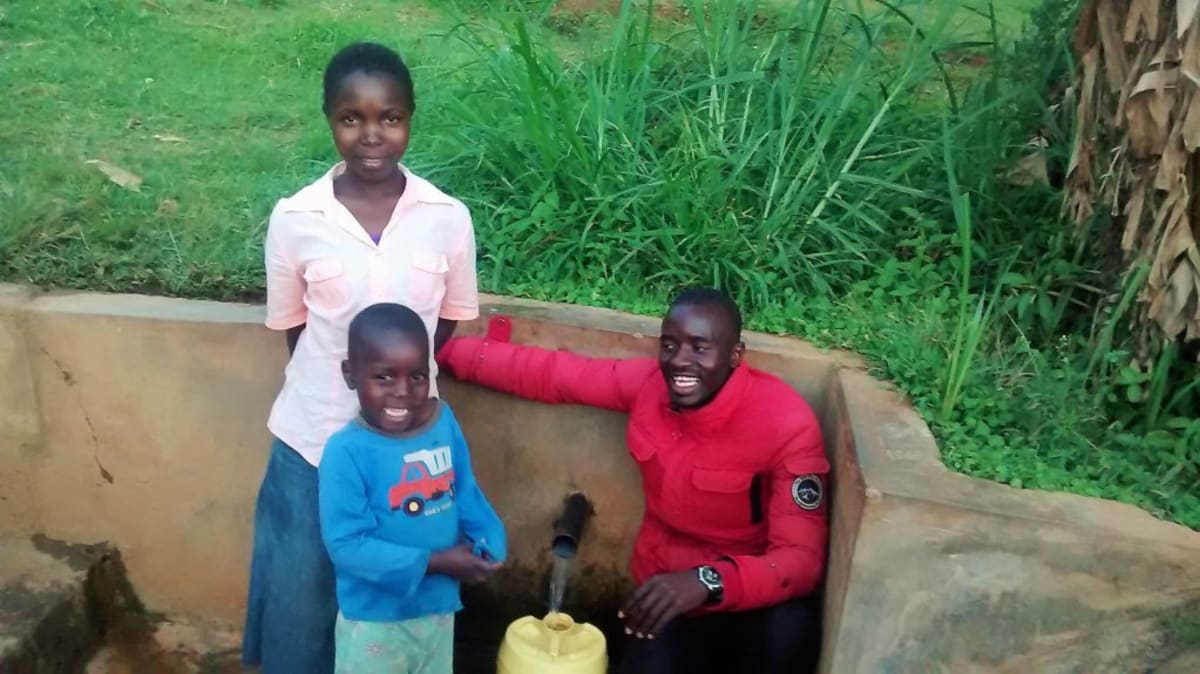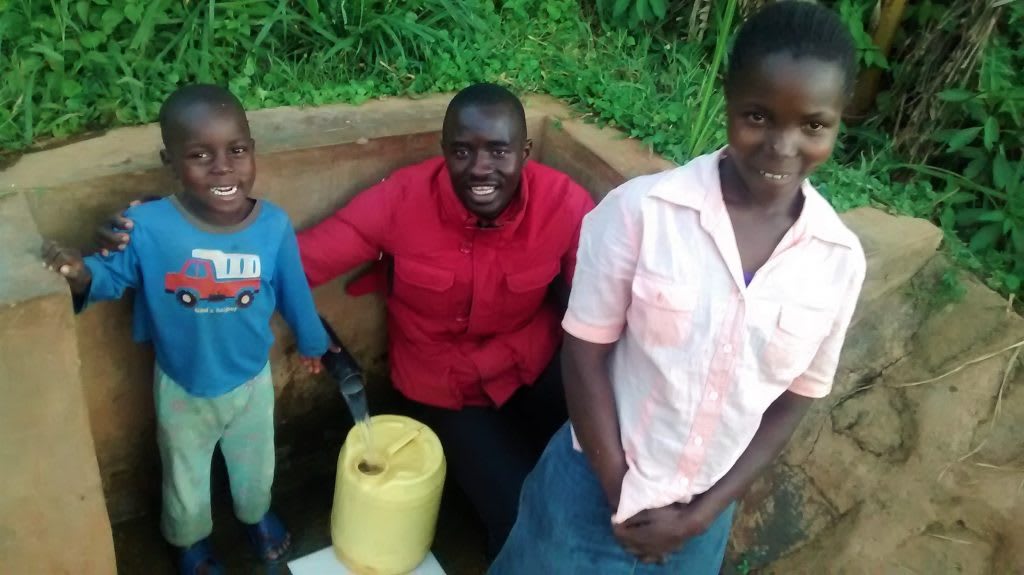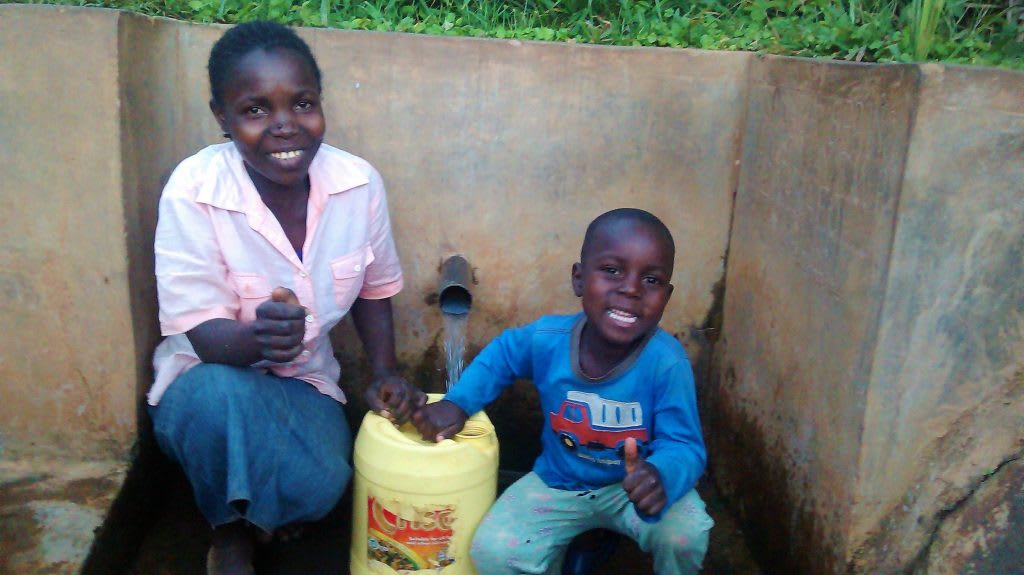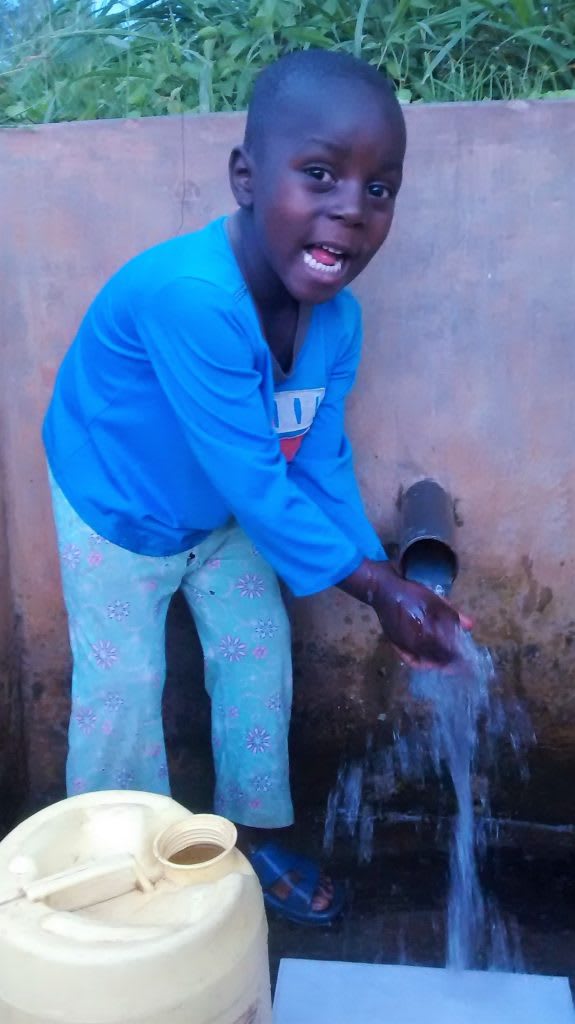This project is a part of our shared program with Western Water And Sanitation Forum (WEWASAFO). Our team is pleased to directly share the below report (edited for clarity, as needed).
Background Information
This unprotected spring is located in Emakunda Village, Mwitubwi sub-location, Mukhalakhala location, Mwibona ward, Luanda sub-county, of Vihiga County. The spring serves 25 households with a total population of 175 people out of which 80 are men and 95 are women.
A typical day looks like: A community member begins the day by going to fetch water, while others go to the farm and others go to the market. To earn a living at the market, villagers sell their products such as maize, beans, bananas, poultry, and other things.
The chairman of Otwato Spring told the owner of Esilaba Spring about the successful project for his community, and asked him to come and visit the site. The owner of Esilaba Spring was indeed very impressed. He got all of the information necessary and then applied for this project to be implemented in his own area.
The Current Source
Esilaba Spring is unprotected. The water is used for drinking, cooking, watering animals and irrigation on farms, especially during the dry period. Community members report that they have suffered from many cases of waterborne problems like diarrhea, typhoid, and stomachache as a result of drinking water from this unprotected spring. It is open to contamination by surface runoff, people stepping into the water as they fetch, and animals that also drink from the water. A lot of time is also wasted by women who have to wait for cloudy water to settle before fetching again. The long wait creates more and more human congestion at the spring, and thus greater contamination. It was also disturbing to note that little efforts are made by the community to improve water quality before use. “We have been drinking that water for years and only very few of us do boil or disinfect it,” commented a beneficiary.
Sanitation Situation
At first look, this community may seem to have an adequate number of latrines. At least 50-75% of households have at least one pit latrine. However, sanitation is still a big problem since the majority of latrines are not safe. The remaining quarter of families have no latrine at all. In fact, those with older latrines will resort to open defecation in order to avoid the dangerous wood floors. “During the rainy seasons most of the fecal waste is being washed into the spring area but we have no much control over this since some people have not appreciated the value of having a facility for safe feces disposal,” an old mama admitted regrettably. Open defecation is an obvious source of contamination for Esilaba Spring's water, but is also an obvious source of reported foot-to-mouth diseases.
Less than 25% of households have tools like a dish rack or clotheslines, opting to air utensils and clothes out on the ground. Less than 25% of households have a bathing room to maintain physical hygiene. Lastly, less than 25% of households have any form of hand-washing station. It is obvious that these community members will greatly benefit from the hygiene and sanitation training that highlights the importance of the above facilities.
Training Sessions
Hygiene and sanitation training will be held over the course of two days: the first day is for learning new healthy practices, and the second day is meant for the education and formation of a Community Health Worker Group. The training facilitator plans to use PHAST (Participatory Health and Sanitation Training), CLTS (Community-Led Total Sanitation), ABCD (Asset-Based Community Development), group discussions, demonstrations, handouts, and a transect walk to teach hygiene and sanitation. The transect walk will teach locals to watch for practices that go on and facilities that are present related to good health and hygiene. Sometimes, a participant feels shame when the group arrives at their household and points out things that are unhealthy or unhygienic; but in Kenya, this affects people to make a positive change. Training participants will also vote on and decide the families that should benefit from the five new sanitation platforms.
The community members are in dire need of support and are willing to partner with WEWASAFO to protect their spring. This construction will go a long way to reduce cases of waterborne diseases, and will also help save women and children time. They are also busy mobilizing the necessary local materials to make this project a success, such as brick, clean sand, ballast, and hardcore. Those from the village will also provide security, accommodations, and food for work teams over the span of this project.
Project Results
Training
The training sessions were held at the homestead of James, the man chosen by the community to be chairman of the spring committee. James and the committee coordinated the training, setting the date and place and letting the community know.
Attendance at the training sessions was good, and the participants were very observant, ready to be equipped with knowledge and skills on good hygiene. This has been a challenge for a long time for this community as they have lacked access to clean water for drinking and cooking.
Topics covered during the sessions included:
- Wash Objectives
- Primary Health care
- Elements of primary Health care
- Environmental Health
- Control measures of common local diseases
- Water related diseases and their prevention
- Understanding disease barriers
- Water handling and hygiene
- Roles of hygiene promoters
- Group dynamics
- Leadership and Governance
- Practical session on site management and maintenance
- Water pollution
Methods used during the training included group discussions, presentations, handouts, a transect walk to investigate open defecation in the community, and practical demonstrations on site. The immediate response was encouraging as people began clearing the bushes around their homesteads, storing in water in clean containers, and washing their hands at critical times as covered in the training.
"We are enjoying safe clean water now which has been a challenge for many years in this community and also going to stop water borne diseases cases," said James Otwali one of the participants.
Spring Protection
Protecting the spring involves building a concrete structure around the water point to shield it from contamination. The process includes the following steps:
- Undertake water quality test
- Clear the site and excavate the foundation to the specified standards
- Excavate the land up slope from the from the spring discharge until three feet of water is flowing
- Create a firm foundation for the base slab, head wall and wing walls
- Do the fitting of delivery pipes, inlets, draw off pipe and overflow inlet screen
- Doing landscaping and drainage work around the site
- Remove potential sources of contamination and direct surface water away from the spring box or collection area by making drainage cut off
The community participated in the project by providing locally available materials like bricks, sand, hardcore and poles for fencing, and also by providing unskilled labor and accommodations for the artisans.
"We are now fetching water from a protected spring and improve on hygiene which is going to stop cases of water borne diseases," said Selipha Alembi, a local business woman.
The community members promised to fence the spring in order to prevent animals and people stepping on the source. Also they will dig the cut off drainage to prevent surface run off from flowing into the spring. Grass will also be planted close to the source. This has been taken seriously with Wanter and Sanitation Management Committee and Community Health Worker committee members who were chosen during the training. The water is used for drinking, cooking, washing and watering animals.
Sanitation Platforms
Sanplats are concrete slabs used as stable floors for pit latrines. Improving the comfort, safety, and ease of cleaning of latrines is an important step in encouraging the community to stop the practice of open defecation which can cause contamination of food and water.
Five households have already benefited from the sanitation platforms which are already installed. "I have been using a latrine with my neighbor because traditionally, I cannot share the latrine with my parents in-law," one sanplat beneficiary said. "Now that we have our own latrine, we shall no longer go to our neighbor neither the children to the bush for short calls," she continued.
Since the community has been equipped with knowledge and skills on good hygiene, the same is now practiced in the community. Water handling at the spring, on the way and at home has improved by women since they are the once mostly carrying water compared to men. The people in this village now have sanitation facilities like the pit latrines, dish racks, clothe lines, and bathrooms.
Thank You for working with us to unlock potential in this community!

 Protected Spring
Protected Spring
 Rehabilitation Project
Rehabilitation Project































